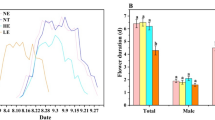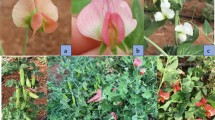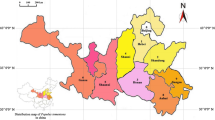Abstract
We observed norms of reaction for life history and floral traits in Raphanus sativus L. (wild radish: Brassicaceae) among genotypes raised in three planting densities. In the greenhouse, we used a nested breeding design to produce F1 seed representing 60 maternal plants and 15 pollen donors grown from field-collected seed. Eighteen hundred seeds were grown in three planting densities in an experimental garden. For each individual, we recorded survivorship, germination date, flowering date, petal area, ovule number, pollen production, and the mode of individual pollen grain volume/ flower. Planting density had a strong effect on survivorship, but differential mortality among genotypes was not density-specific. Two-way ANOVAS (block and density as class variables) were conducted on each paternal sibship to detect significant differences among densities with respect to mean phenotype. Among the 15 paternal genotypes, 12 exhibited significantly faster germination in the high-density plots. Three paternal families exhibited significantly delayed flowering at high-density. Two paternal families exhibited significant effects of density on petal area, but in opposite directions. Two paternal families had significantly lower ovule production at high-density. No paternal families exhibited significant effects of density on pollen production or pollen-grain volume. Strong differences among genotypes with respect to the effects of density on phenotype indicate genetic variation in the plastic response to density for these traits. Three-way ANOVAS of each density treatment measured the effects of block, paternal family and maternal family on phenotype; significant paternal effects indicated the presence of significant additive genetic variance ( VA) in the measured trait. The ability to detect VA and maternal effects nested within paternal genotypes in most of these traits was density-specific.
Similar content being viewed by others
Article PDF
References
Becker, W A. 1984. Manual of Quantitative Genetics. Academic Enterprises Pullman, Washington. 4th edn.
Comstock, R E, and Robinson, H F. 1948. The components of genetic variance in populations of biparental progenies and their use in estimating the average degree of dominance. Biometrics, 4, 254–266.
Devlin, B. 1988. The effects of stress on reproductive characters of Lobelia cardinalis. Ecology, 69, 1716–1720.
Hallauer, A R, and Miranda, J B. 1981. Quantitative Genetics in Maize Breeding. Iowa State University Press, Ames, Iowa.
Lande, R. 1976. Natural selection and random genetic drift in phenotypic evolution. Evolution, 30, 314–334.
Lande, R. 1979. Quantitative genetic analysis of multivariate evolution applied to brain: body size allometry. Evolution, 33, 402–416.
Lande, R. 1980. Genetic variation and phenotypic evolution during allopatric speciation. Am Nat, 116, 463–479.
Lewis, D, Verma, S C, and Zuberi, M I. 1988. Gametophyticsporophytic incompatibility in the Cruciferae — Raphanussativus. Heredity, 61, 355–366.
Marshall, D L, and Ellstrand, N C. 1986. Sexual selection in Raphanus sativus: experimental data on non-random fertilization, maternal choice, and consequences of multiple paternity. Am Nat, 127, 446–461.
Mazer, S J. 1987a. The quantitative genetics of life history and fitness components in Raphanus raphanistrum L. (Brassicaceae): ecological and evolutionary consequences of seed-weight variation. Am Nat, 130, 891–914.
Mazer, S J. 1987b. Parental effects on seed development and seed yield in Raphanus raphanistrum: implications for natural and sexual selection. Evolution, 41, 355–371.
Panetsos, C A, and Baker, H G. 1967. The origin of variation in ‘wild’ Raphanus sativus (Cruciferae) in California. Genetica, 38, 243–274.
Putrament, A. 1960. Studies in self-sterility in Raphanus sativus (L.) var. radicula (DC) Act Soc Bot Pol, XXIV, 289–313.
Sas Institute, Inc., 1987. SAS/STAT Guide for Personal Computers, Version 6 Edition. SAS Institute Inc., Cary, North Carolina.
Schlichting, C D. 1986. The evolution of phenotypic plasticity in plants. Ann Rev Ecol Syst, 17, 667–693.
Service, P M, and Rose, M R. 1985. Genetic covariation among life-history components: the effect of novel environments. Evolution, 39, 943–945.
Shaw, R G. 1986. Response to density in a wild population of the perennial herb Salvia lyrata: variation among families. Evolution, 40, 492–505.
Stanton, M L. 1984a. Developmental and genetic sources of seed weight variation in Raphanus raphanistrum L. (Brassicaceae). Am J Bot, 71, 1090–1098.
Stanton, M L. 1985. Seed size and emergence time within a stand of wild radish (Raphanus raphanistrum L.): the establishment of a fitness hierarchy. Oecologia, 67, 524–531.
Stanton, M L. 1987a. The reproductive biology of petal color variants in wild populations of Raphanus sativus L.: I. Pollinator response to color morphs. Am J Bot, 74, 178–187.
Stanton, M L. 1987b. The reproductive biology of petal color variants in wild populations of Raphanus sativus L.: II. Factors limiting seed production. Am J Bot, 74, 188–196.
Turelli, M. 1988. Phenotypic evolution, constant covariances and the maintenance of additive variance. Evolution, 42, 1342–1347.
Via, S, and Lande, R. 1987. Evolution of genetic variability in a spatially heterogeneous environment: effects of genotype-environment interaction. Genet Res, 49, 147–156.
Westerman, J M. 1971a. Genotype-environment interaction and developmental regulation in Arabidopsis thaliana. II. Inbred lines; analysis. Heredity, 26, 93–106.
Westerman, J M. 1971b. Genotype-environment interaction and developmental regulation in Arabidopsis thaliana. III. Inbred lines; analysis of response to photoperiod. Heredity, 26, 373–382.
Westerman, J M. 1971. Genotype-environment interaction and developmental regulation in Arabidopsis thaliana. IV. Wild material; analysis. Heredity, 26, 383–395.
Westerman, J M, and Lawrence, M J. 1970. Genotype-environment interaction and developmental regulation in Arabidopsis thaliana. I. Inbred lines; description. Heredity, 25, 609–627.
Young, H J, and Stanton, M L. 1990. Influence of environmental quality on pollen competitive ability in wild radish. Science, 248, 1631–1633.
Author information
Authors and Affiliations
Rights and permissions
About this article
Cite this article
Mazer, S., Schick, C. Constancy of population parameters for life history and floral traits in Raphanus sativus L. I. Norms of reaction and the nature of genotype by environment interactions. Heredity 67, 143–156 (1991). https://doi.org/10.1038/hdy.1991.74
Received:
Issue date:
DOI: https://doi.org/10.1038/hdy.1991.74
Keywords
This article is cited by
-
Genotype-by-Environment Interactions for Seedling Establishment Across Native and Degraded-Forest Habitats in a Long-Lived Cycad
The Botanical Review (2013)
-
Evolution of enhanced reproduction in the hybrid-derived invasive, California wild radish (Raphanus sativus)
Biological Invasions (2009)
-
Genetic constraints on floral evolution: a review and evaluation of patterns
Heredity (2006)
-
Floral trait variation in Spergularia marina (Caryophyllaceae): ontogenetic, maternal family, and population effects
Heredity (1996)
-
Modelling phenotypic plasticity. II. Do genetic correlations matter?
Heredity (1996)



